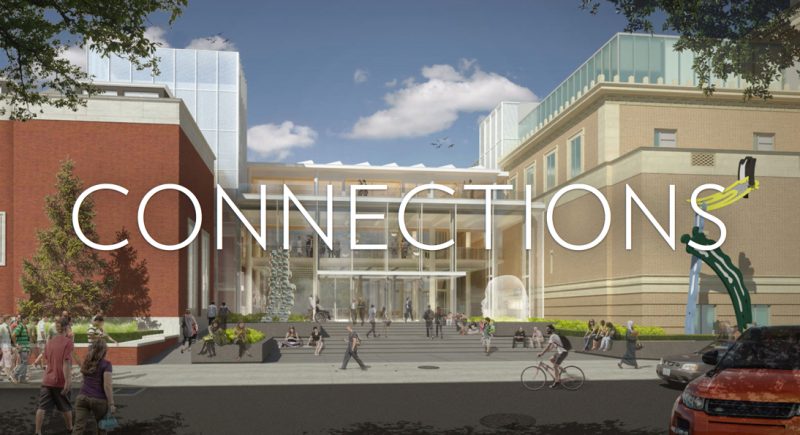
Nearly eight months after their initial request to change a public easement to make room for the new Rothko Pavilion was strongly rebuffed, the Portland Art Museum is trying again.
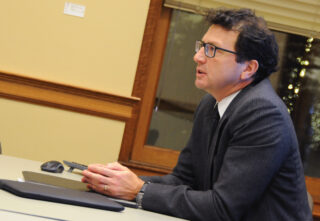
(Photo: J. Maus/BikePortland)
At the Portland Bicycle Advisory Committee meeting last night in City Hall, PAM’s Executive Director Brian Ferriso struck a conciliatory tone. The BAC (along with the Pedestrian Advisory Committee) formally opposed the initial plans because the new pavilion would enclose the existing Madison Plaza.
Referring to the pushback from the BAC in March, Ferriso opened his comments last night by saying, “I gained a new appreciation for the important work that happens in this room.”
Here’s the background:
SW Madison used to continue through the block that currently houses several museum buildings. When the street was vacated (a.k.a. closed to motor vehicle use) to create a plaza, the public maintained the right to pass between these building due to an easement that’s been on the books since 1968. That initial easement allowed public passage 24 hours a day and required a minimum path width of eight feet (actual width is more like 10-12 feet wide). In 1984 the museum requested — and was granted — permission to close the plaza at night due to security and vandalism concerns.
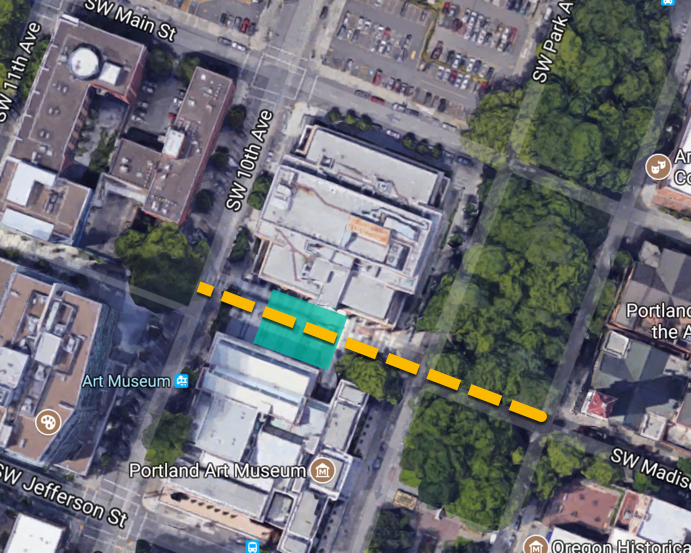
(Graphic: BikePortland)
“I think ultimately for us, it’s about a big investment in the cultural and educational life of our city core.”
— Brian Ferriso, Portland Art Museum
In order to build their new Rothko Pavilion — which they’ve already raised about $50 million for — PAM wants to enclose a portion of the plaza with a structure to connect the two buildings and create a new main entrance. They need city council to approve a change to the existing easement. The sticking point for people concerned about connectivity (many of whom use the plaza to walk and bike between SW 10th and the Park Blocks), was that — while it would be free to enter the new enclosure — the museum’s initial request would have limited access to the plaza to museum hours of 10:00 am to 5:00 pm Sunday through Wednesday and 10:00 to 8:00 pm Thursday and Friday. Another controversial part of the initial request was that bicycle access (and dogs) would be prohibited.
Beause of considerable opposition from the community back in April, city council shelved the proposal.
Last night Ferriso shared a new proposition: Bicycles and pets will be welcome through the new pavilion from 7:00 am to 11:00 pm every day of the week. This is a significant expansion of hours and access.
However, much to the committee’s chagrin last night, Ferriso shared no new visuals of the design and offered no details about how people would get through the new enclosure. A big concern is that having an enclosed structure across what’s now an open plaza will discourage public access, further erode the street grid, and reduce connectivity of the biking and walking network.
Ferriso told the commmittee the tradeoff is well worth it. “I think ultimately for us, it’s about a big investment in the cultural and educational life of our city core.” The new pavilion would also vastly improve accessibility for museum-goers with its new ground-floor plan. “It’s currently a very difficult campus to navigate,” Ferriso added, “Our overall vision is to make it much more accessible and make sure barriers are taken down for the community.”
Advertisement
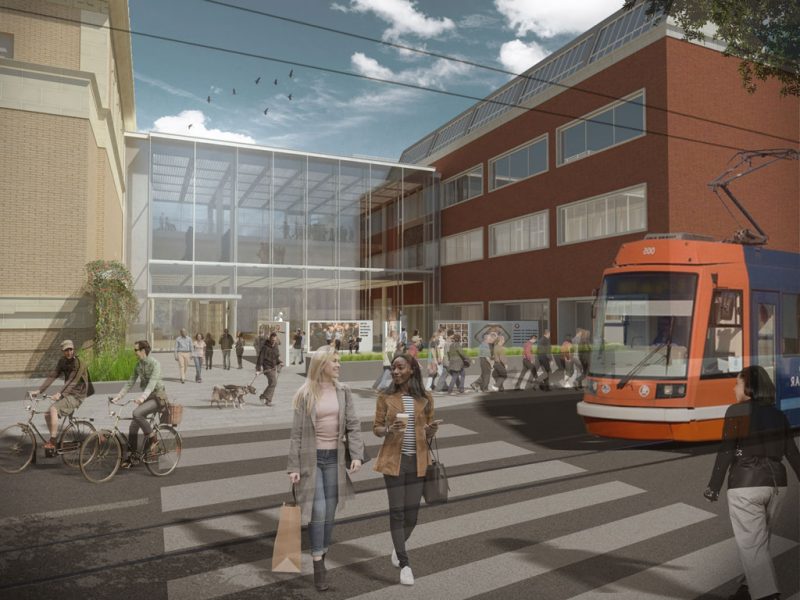
Committee members were supportive of the museum’s vision and appreciative of the increase access; but they remain concerned about the lack of detail and specifics about how exactly people on foot and bike would pass through.
“If this is a door, that’s not going to work.”
— Chris Achterman, BAC member
“You’re going to have a very diverse population trying to access it; people on bikes, people in wheelchairs,” BAC member Chris Achterman said. “So if this is a door, that’s not going to work.” Achterman referred to the design of Amsterdam’s Rijksmuseum which has a bikeway that bisects the building (I called it one of the wonders of the bicycle world after a 2013 visit). “I hope that as you approach this project you see it as Portland’s version of the Rijksmuseum.”
“That’s a point well-taken,” Ferriso replied.
“I think further clarification is needed before I can provide an opinion.”
— Roger Averbeck, BAC member
BAC member Roger Averbeck also wondered about how the access would work. “If someone comes through on a bike, can they ride their bike through? Or do they have to get off and walk?” he asked. “What about if they’re on a skateboard?” “That’s a good question,” Ferriso replied. “If you said it’d be important to ride through, we’d take that as feedback.”
“If somebody has to stop, open a door, then open another door,” Averbeck continued, “It doesn’t seem like a place that somebody’s going to be simply traveling through to get from point-a to point-b using a variety of devices including shoes and bikes and wheels and who knows what else. I think further clarification is needed before I can provide an opinion.”
Ferriso acknowledged the lack of fine-grain design details. The current conceptual drawings they have now were done to entice donors and were not meant to be detailed engineering documents.
“All our questions revolve around a design, and you’re not showing a design.”
— Eliot Akwai-Scott, BAC vice-chair
And that’s the rub: The BAC and others are concerned about how exactly the doors or passageway would work, but PAM is saying they can’t answer that question yet. City council isn’t signing off on a detailed design at this point, the only thing technically up for debate is a change to the easement that would allow PAM to move forward and build an enclosed structure. The design of that structure is something that would go through a public process with the Landmarks Commission.
BAC member Keith Liden expressed discomfort with this situation. “We’re being asked to sign off on hours of operation, but we haven’t seen the design yet. We still don’t know what we’re getting. That’s my concern.”
“All our questions revolve around a design, and you’re not showing a design,” added BAC vice-chair Elliot Akwai-Scott. “Given that, you already presented this to council earlier and it sounds like the proposal is more or less unchanged other than an agreement to open the doors [to bicycle users and for longer hours]. What’s the urgency for brining it back to council now, instead of waiting for designs to change and incorporate feedback?”
Ferriso replied that in order to continue fundraising, he needs the basic concept approved before they can move forward to the next phase of design.
In one of the last comments of the night, BAC member Jocelyn Gaudi encouraged the museum to, “Be creative and be humble that this was a former right of way… I love interacting with art when I ride. This is a unique opportunity for that.”
The BAC didn’t take a vote on the issue last night. The museum’s ordinance is on the council agenda for December 7th at 2:00 pm. See a FAQ and learn more about the Rothko Pavilion at PortlandArtMuseum.org.
— Jonathan Maus: (503) 706-8804, @jonathan_maus on Twitter and jonathan@bikeportland.org
Never miss a story. Sign-up for the daily BP Headlines email.
BikePortland needs your support.




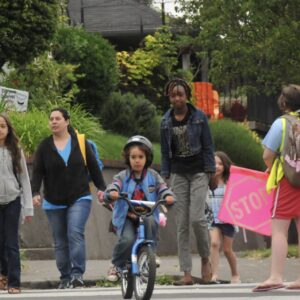
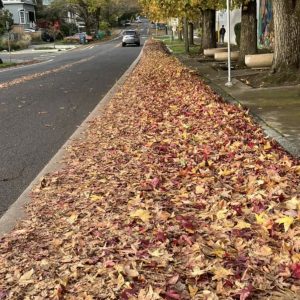
Thanks for reading.
BikePortland has served this community with independent community journalism since 2005. We rely on subscriptions from readers like you to survive. Your financial support is vital in keeping this valuable resource alive and well.
Please subscribe today to strengthen and expand our work.
Thanks for representing us well, BAC members.
This statement seem’s ironic and unsubstatiated:
It’s currently a very difficult campus to navigate,” Ferriso added, “Our overall vision is to make it much more accessible and make sure barriers are taken down for the community.”
I especially appreciate this statement:
“All our questions revolve around a design, and you’re not showing a design,” added BAC vice-chair Elliot Akwai-Scott. “Given that, you already presented this to council earlier and it sounds like the proposal is more or less unchanged other than an agreement to open the doors [to bicycle users and for longer hours]. What’s the urgency for bringing it back to council now, instead of waiting for designs to change and incorporate feedback?”
And Jocelyn Gaudi’s encouragement to the museum to, “Be creative and be humble that this was a former right of way… I love interacting with art when I ride. This is a unique opportunity for that.”
This is a tremendous opportunity.
Let’s hope the PAM takes this feedback into consideration and revises their design accordingly.
Once doors are built, it’s all too easy to change the hours they’re open, or to start out requiring bikes to be walked, and then prohibit bikes, and make walkers put on a lapel pin and show it at the other door, etc., etc.
It’ll be like the US Bank building at 5th and Ankeny. No-one knows that the public is allowed to walk through, so few would consider doing so in the evening.
The reason their “Campus” is difficult to navigate is because they won’t let their patrons enter the northern building at ground level off the plaza. They make them go underground. If they’d just open that ground-level door, their patrons could walk across the plaza at ground level. They’d just have to staff that door.
Or, they could build a bridge over the plaza, with exhibits, at the second and third floor levels. They really just want to stop people walking through the easement, and take over the space for their use.
I love walking through the bank building by Ankeny, especially after they closed off the architecture walkway by the Starbuck’s a few years ago.
It’s important to note he also said the space would be “manned” for security, which of course calls into question who might NOT be allowed to go through, you know, for security purposes.
That’s funny. I do walk through the US Bank building, but did not know that it’s officially allowed. I just figured the doors are unlocked, so why not.
No. Return it to 24/7 access.
A big NO to any kind of access that requires entering and exiting the building. Way too easy to come up with a reason to lock those doors earlier in the day sometime in the future. The easement needs to maintain a passage with no gates. With how high the connection is planned to be there is no reason why the connection can’t be a sky bridge allowing for free passage beneath it at all hours.
““If you said it’d be important to ride through”
DO YOU KNOW HOW BIKES WORK?!
Are the sidewalks at either end of the right of way currently exempt under the downtown sidewalk ordinance? Seems like there is an exception to the prohibition for sidewalks “designated as bike lanes or paths.” If not formally designated, it could be done during this process.
Keep the ground floor clear- no fences, gates or buildings. A beautiful second floor exhibition space could provide a lot of great connectivity for the museum
Considering the intrinsically limited number of fucks that everyone, including the BAC members, has to give about things, this seems like a questionable allocation of them. The block in question isn’t all that great to ride through anyway. There are better hills to die on.
it’s ok bud, the rain goes away in a few months
This isn’t primarily about bike access, it’s about public access. There need to not be physical barriers to using this public right of way.
I never knew the US Bank plaza was open to the public, even as a longtime Portlander who still stays downtown regularly. Same will happen here: most people won’t realize it’s a public right of way.
As others have suggested, they need to either go up to the 2nd floor or underground (don’t they already have an underground passage there?) to connect the buildings. They can build a covered and semi- enclosed plaza on the ground level, but only if passage by the public is unobstructed.
The two buildings are indeed linked with an underground passage. It’s inconvenient for visitors to have to go down to the basement to get to the modern art wing. The museum needs, at minimum, a skybridge for better connections. A second-and-third floor “bridge” gallery sheltering an open plaza would be preferable. But they really don’t need a street-level connection.
Yeah, I now think they should be building an amazing subterranean gallery in this space, with pedestrians and bicyclists moving through the plaza as they currently do, and maybe some grand staircases descending into the space that would be locked outside of business hours. Maybe use some glass pyramid skylights for the connecting underground gallery, just like the Louvre.
Thanks for the coverage. Brian Ferriso’s comment about needing to get design approval in order to continue fundraising is weak. Pushing an inequitable and dysfunctional idea forward is short-sighted. In Portland, where creativity is so celebrated, they’d likely raise more funds with a design that could be shown to benefit the entire community, not just museumgoers. Glass floor, second story connection with a grade-level unobstructed passage: Why not?
Yes !
“If this is a door, that’s not going to work.” Exactly.
They’ve already raised 50 million?! Let’s be wary that they don’t create an opportunity with Council to ‘buy’ our public space – with cash, in-kind, or otherwise.
A skybridge is an obvious answer, though not so deep that it creates an ominous tunnel; and with written agreement that the public is allowed to congregate underneath, in this public space.
I had no idea that the US Bank building has public access.
The right-of-way along NE 12th between NE Lloyd and NE Holladay should be a cautionary tale here: That is also a permanent, public right-of-way. The owner felt it was too much trouble so that convinced the City to let them install a gate. The gate is supposed to be open to the public, but it never is. That public space is effectively gone. I would take any promises from the museum with a grain of salt. Once there is building occupying the space, then they just wait for an excuse to start limiting access.
Good point. It reminds me of the houseboat moorage on the westside just north of the Sellwood Bridge. That compound has a lease with the state that has conditions that the dock be open to the public during certain hours, and that it allow the public to dock boats there. But the entrance gate has often been locked during public hours, and the sign designating the public dock tie-up area was taken down years ago. Some residents are clearly fine with visitors, others give you the stink-eye.
Anything short of an open ground level won’t work. Any restricted access will be a failure to the public, because even if 24-hour public access is legally allowed, and even maintained (contrary to our examples) the museum won’t WELCOME the public. The public will be made to feel like intruders, and the museum will feel either that the public ARE intruders, or at least that the public is there due to the goodwill of the museum, which of course is backwards.
My husband and I are PAM neighbors, members and donors. We are excited about the investment the museum wishes to make in downtown. However the design the Pavilion proposed will create security problems and severely limit transit passage.
The Ordinance reads:
“the vacated street will not be used for any purpose other than an open mall.”
During the Bicycle Advisory Commission review last night, PAM made no mention of the stairs needed – the vertical access – up to and down from the new pavilion which is 4 feet above existing plaza level. Passage between 10th Avenue and the Park Blocks will require bikers and walkers to go up and down and through the Pavilion. The existing plaza has an open flat walkway at street level.
Door access, in and out of the Pavilion will be limited because these doors function as an ‘air lock’ to control humidity for the museum’s artwork. The museum has not shown in their renderings the type of doors or ‘man trap’ vestibules they will need to obtain the required ‘air lock’. An ‘air lock’ will impede passage and may eliminate bicycle passage altogether.
As you can see from the Museum’s renderings the new pavilion will not house Rothkos or any other paintings because of the extreme sunlight and humidity would damage paintings and many types of artwork. It will function as a glassed in corridor, above the street level, to connect their buildings and house the outdoor sculptures that are now in the Plaza. Bringing the existing courtyard sculptures inside the Pavilion closes off any exposure passersby might have to art.
The security concerns for our neighborhood remain unaddressed. While the Museum intends to provide security inside the Pavilion during their ‘open’ hours, homeless folks and others using the tree screened cul de sac areas created by the museum’s design will be a safety concern for the mega block 10th Avenue and Park Blocks frontage.
We hope the Museum will consider its neighborhood and a connection on the upper floor levels which would allow safe, accessible passage on the existing vacated street. This vacated public street that was ordained to be an ‘open mall’ has become a passageway and successful plaza that is an integral part of Portland’s urban fabric and was not taken into account by the Museum’s Chicago designer team.
We hope that the City Council will hold off on any Ordinance changes until the Museum proposal resolves these important problems.
They’re just wasting our time without new plans and renderings. They showed a lack of respect and now need to provide an IMPROVED access plan from the current situation. Rijksmuseum or bust I say.
This article should come with a feature that allows me to “select all” of the comments so I can recommend them all (well, almost all) with one check.
I’ve been a visitor to Portland, many times. Walked Madison between the two museum buildings, many times. I prefer the no motor vehicles, open breezeway that the museum borrowed from for its defining character of accessibility. Each time I see and study the artists rendering of the proposed pavilion’s design, reinforces my feeling that this is not a good design. It’s not inspiring. It’s design, viewed from the exterior, is nothing more than a glass wall.
What’s it doing there? It looks like something that doesn’t belong. Like some temporary knocked up structure for the purpose of isolating, and nothing more, the more delicate of visitors to the museum, from the rain, chill air, sunshine outside the museum interior. If this is the best design the Portland Art Museum can come up with, that’s a sad statement about the future of art inspiration and appreciation that can be expected from the museum.
The museum not having at least conceived a great sky-bridge design to connect its two buildings, instead of the glass wall they seem intent on building, is disappointing. The U.S. has many great architects. Out of all those architects, it’s hard to believe this is the most inspiring yet functional design that the museum had presented to it, and that it could afford to build.
I agree. One thing about the architects, though—I’d guess the ones they have would be capable of designing something much better. Architects are only as good as their clients let them be. Also, since they’re working for the client, they’ll defend the client’s position. So if the client doesn’t want to keep the ground floor open, then the architects will present all the difficulties associated with that.
If the museum had started with wanting the ground floor open, the architects would have come up with a design that accomplishes that, and a list of all the reasons it’s a good idea. And if the City and public for some reason didn’t wanted it closed off, they’d have a list of all the reasons why closing it off would be bad.
The phrase most telling for me of the PAM’s intentions is as follows:
“Ferriso told the commmittee the tradeoff is well worth it. “I think ultimately for us, it’s about a big investment in the cultural and educational life of our city core.”
Note that he says “FOR US” not for the city, not for the people. He was saying that for the museum and its donors, this is a big investment for themselves about themselves.
I would prefer that they do their design and fundraising by focusing on how this can help the CITY as a whole, and not just themselves.
They haven’t been enforcing the 0700-2300 restriction for years. It’s been open 24×7 since I moved into the area in 2010. If you don’t enforce something like that, does it become invalid, as a rule of the Commons, or something? Like, companies who say that they have to sue to protect a trademark because if they don’t it becomes impossible to defend it later? (I’m not a lawyer, obviously.)
This is simply the elite looking to get something for nothing.
It’s funny, your comment (which I like) made me think–what if instead of the museum, it was a private business asking to close a street downtown. Say IKEA wanted to open a downtown store, or Nike wanted to build a flagship NikeTown, with a similar offer to let the public pass through their lobby during business hours. People would say that giving them the street would be crazy, and I’d agree.
On the other hand, IKEA or Nike would welcome everyone who came into their lobbies to go through the whole rest of their place for free. There would not be the same “no passers-thru beyond this point without paying” situation that the museum proposes, which to me will make those passing through feel like part of a second-class group that’s being tolerated but not welcomed.
Can the PAC/BAC just resend their letter from April, objecting to the proposal? Except for the hours, the rest of the proposal is apparently the same, and the objections stated then still apply. I may just read from that letter on Dec 7.
That’s a great question, Doug.… And it makes sense. I’ve been watching the excellent documentary on the Rijks Museum. There are some significant differences between our situation here and the one in Amsterdam, but there are also some similarities that apply.
Unfortunately, hiring a lobbyist was the choice the Museum made in order to ram this through as is. Tedd Chilless, a local architect, submitted some great drawings to the Commission during the December 7th hearing showing how door free open passage could be integrated. Countless museums and building around the world solve this common problem with great creativity. But according to the museum’s director, this new building needs to be the ‘airlock’ for the museum because they simply can’t figure out a way to incorporate airlock doors on the Marks building plaza entrance now. Not sure I can manage 2 sets of double doors or revolving doors with my bike.
Fascinatingly the Museum asked a 93 year old disabled docent and patron to testify. She described arriving most weeks to find no one staffing the north entrance – so she sits and waits in the cold and rain until someone finds her. But somehow they have the money to staff and patrol the pavilion’s new ground floor store and ticket area for 16 hours 365 days of the year?
If the museum hired a lobbyist who’s trying to convince everyone to let them build a new lobby, maybe we should get them to hire a pass-throughist.